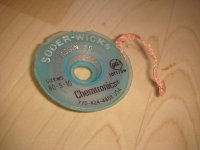I am currently using GootWick. It has worked well for me. I am running shy and plan to buy some more online. If you buy it out of China (yikes) it is fairly low cost.
What is meant by the term "No Clean"?
Any recommendations?
What is meant by the term "No Clean"?
Any recommendations?
"No Clean"
Does this wick contain flux?
If so "no clean" refers to the flux and means You don`t have to clean flux residuals off the board. Some kinds of flux act corrosive and can harm the PCB or electronic components. Flux residues can also be slightly conductive and disturb functionality of a sensitive electronic circuit.
However, I`d clean flux residue always, even "no-clean", just to be on the safe side or be it for cosmetic reasons only.
Does this wick contain flux?
If so "no clean" refers to the flux and means You don`t have to clean flux residuals off the board. Some kinds of flux act corrosive and can harm the PCB or electronic components. Flux residues can also be slightly conductive and disturb functionality of a sensitive electronic circuit.
However, I`d clean flux residue always, even "no-clean", just to be on the safe side or be it for cosmetic reasons only.
Stick with goot.
I've tried the other stuff and it doesn't work anywhere nearly as well. (I think the difference is the goot wick is a finer mesh and has a better flux)
"no clean" simply means it has a very mild flux that can be left on the PCB. It doesn't work as well. Unless you're a big workshop that will save $$ by not cleaning, I think you should avoid the "no clean" variety. PCBs should always be cleaned with alcohol after any work.
I've tried the other stuff and it doesn't work anywhere nearly as well. (I think the difference is the goot wick is a finer mesh and has a better flux)
"no clean" simply means it has a very mild flux that can be left on the PCB. It doesn't work as well. Unless you're a big workshop that will save $$ by not cleaning, I think you should avoid the "no clean" variety. PCBs should always be cleaned with alcohol after any work.
I learned how to make Solder Wick from its inventor at AMPEX in 1969.
You can make it for a fraction of the cost. After soaking the braid
in flux, dry it with a heat gun. Use the empty Solder-Wick spools to keep it fresh.
3/32" x 100 ft. Flat Tinned Copper Braid is under $25, this may not be the fine braid needed for good wicking.
Minute Man Electronics Tinned Copper Flat & Round Braid
Liquid flux, $9
Liquid Solder Flux, 2 oz. | 20-1100 (201100) | Distributed By MCM
Wayne
You can make it for a fraction of the cost. After soaking the braid
in flux, dry it with a heat gun. Use the empty Solder-Wick spools to keep it fresh.
3/32" x 100 ft. Flat Tinned Copper Braid is under $25, this may not be the fine braid needed for good wicking.
Minute Man Electronics Tinned Copper Flat & Round Braid
Liquid flux, $9
Liquid Solder Flux, 2 oz. | 20-1100 (201100) | Distributed By MCM
Wayne
Don't buy Goot wick from China directly. The genuine Goot wick is great, some of the most effective solder wick I've ever used. However, I ordered a few rolls from a China based seller on eBay and what turned up looked exactly like the real thing but simply didn't work; solder would not wick up the braid. I'm guessing that it used an inferior flux or something like that.
Geniune Goot wick is a bit on the expensive side for me, I now use Edsyn 'Soldasip' which seems to be just as good. Besides this, I hardly use wick after getting a good solder sucker, an Edsyn SS750LS.
Geniune Goot wick is a bit on the expensive side for me, I now use Edsyn 'Soldasip' which seems to be just as good. Besides this, I hardly use wick after getting a good solder sucker, an Edsyn SS750LS.
I usually add flux, when using solder braid. It speeds up work and improves the overall result.
regards
regards
Thanks everyone for the great insight. You do have to be on guard when puchasing anything from china. The old saying: You get what you pay for. So I will stick with Goot.
- Status
- Not open for further replies.
- Home
- Design & Build
- Equipment & Tools
- Solder Wick
